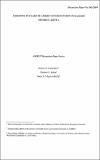| dc.contributor.author | Kamcndcri', Morris G. | |
| dc.contributor.author | Kibua, Thomas N. | |
| dc.contributor.author | Migot-Adholla, Shem E. | |
| dc.date.accessioned | 2021-09-29T20:50:11Z | |
| dc.date.available | 2021-09-29T20:50:11Z | |
| dc.date.issued | 2009 | |
| dc.identifier.uri | http://repository.amref.org/handle/123456789/266 | |
| dc.description | The publishers will gladly consider any request for permission to reproduce part or the
whole of this publication with the intention of increasing its availability to those who
need it. AMR.EF welcomes enquiries from individuals or organisa1ions wishing to use the
con1en1 for non-commercial purposes. | en_US |
| dc.description.abstract | AMREF has been implementing health interventions in Kajiado District, Kenya, since the early
1960s. At that time, the rationale was that the pastoral communities were marginalised and in dire
need of health services. Over the years, AMREf"s interventions in the district have evolved and
responded to specific and changing needs of the communities. This paper attempts to assess the
impact of this long-term engagement and has employed a combination of different methodologies
which included: a review of existing documentation within AMREF on programme/project
design, reports and evaluations; a review and analysis of official secondary data; and collection
and analysis of primary data from beneficiaries and key infonnants on their perceptions of project
impact. A matrix was created to assist in collating and outlining all project information in a
systematic and sequential manner ensuring that all projects covered within the period in question were examined.
The findings indicated that while the intended intervention outputs had been achieved, the
demographics of the district had substantially shifted thereby altering the characteristic of target
population. It was also found that, to a large extent, the health status of the communities in
Kajiado had improved as a result of the interventions. Further, the interventions had enhanced the
capacity of the communities to partner in their own health and contributed to strengthen ing the
health system. However, because of the inherent lack of consistent adequate documentation of
critical information and the fact that there were many other organisations implementing simi ar
projects, it is difficult to attribute all the achievements to AMREF alone. | en_US |
| dc.description.sponsorship | AMREF HQ | en_US |
| dc.language.iso | en | en_US |
| dc.publisher | AMREF | en_US |
| dc.relation.ispartofseries | Discussion Papers;No. 00212009 | |
| dc.subject | AMREF | en_US |
| dc.subject | Nomadic | en_US |
| dc.subject | Kajiado | en_US |
| dc.subject | Mobile Health | en_US |
| dc.subject | Community Based Health Care | en_US |
| dc.subject | Trachoma | en_US |
| dc.subject | Water and Sanitation | en_US |
| dc.subject | Community | en_US |
| dc.title | Discussion Paper No. 002/2009 - Assessing 50 Years of Intervention in Kajiado District, Kenya 002-2009. | en_US |
| dc.type | Other | en_US |

